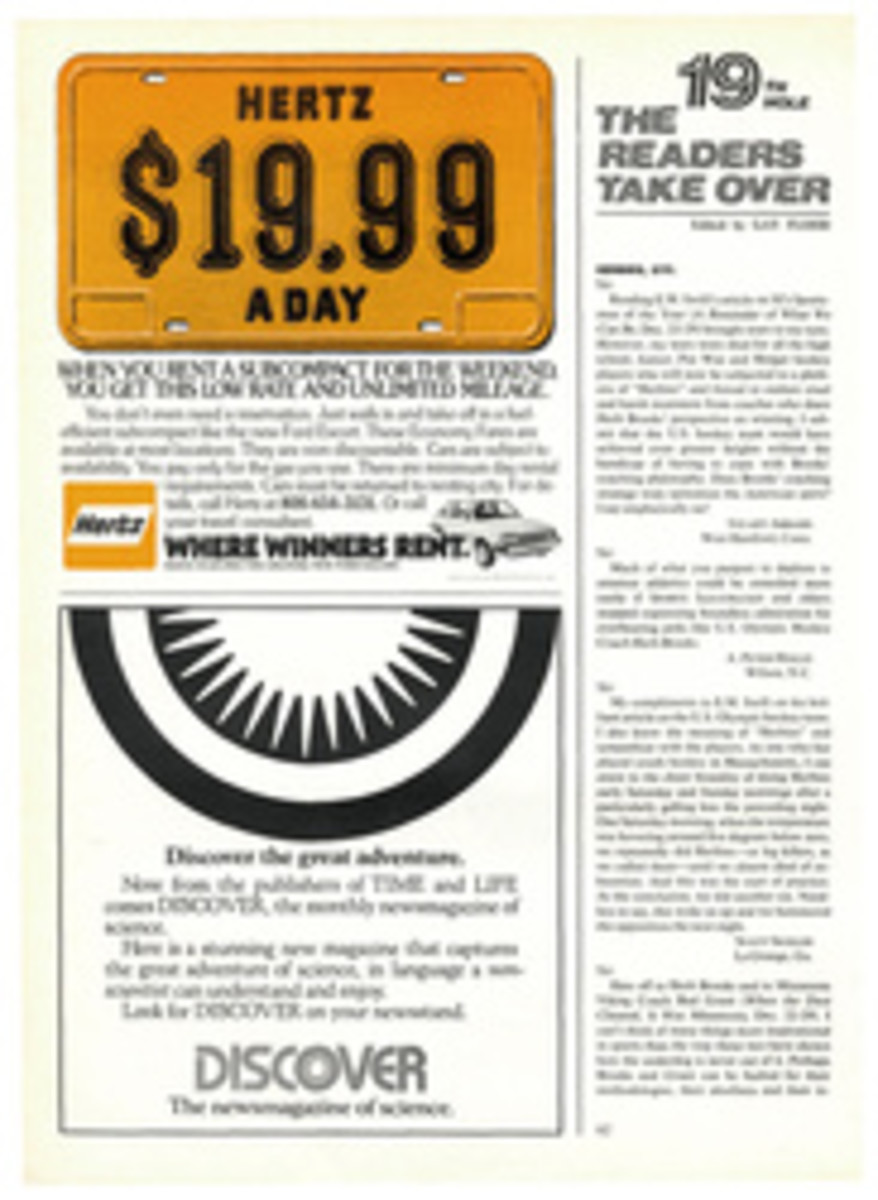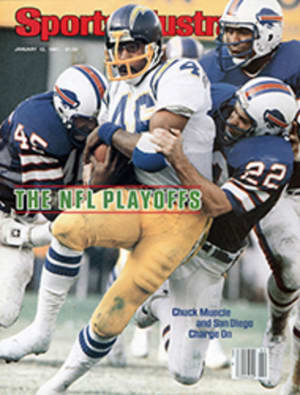
Top banana at Tampa Bay
When George Steinbrenner took over the New York Yankees in January of 1973, he said, "I won't be active in the day-to-day operations of the club at all. I can't spread myself too thin. I've got enough headaches with my shipbuilding company." Almost eight years later, on Dec. 4, 1980, on the patio of the VIP lounge at Tampa Bay Downs in Oldsmar, Fla., Steinbrenner stood somewhat removed from a large group of celebrities, including Pitcher Tommy John, former football coaches Lou Saban and Ray Graves, broadcaster Phil Rizzuto and the nation's most prominent thoroughbred breeder, Brownell Combs of Lexington, Ky., and said, "No, I will not be involved in the day-to-day operation of Tampa Bay Downs. With the Yankees and The American Ship Building Company, I just have too much to do. I can't spread myself too thin."
But it seems that Steinbrenner is very elastic, finding time to indulge in any number of whims and fancies, including a little-publicized passion for washing cars. His most recent undertaking had its genesis last March when he bought a major interest in aging Florida Downs for an undisclosed price. Surely it was millions; the plant is situated on 508 acres, the largest tract of land surrounding any U.S. racetrack. One of the first things Steinbrenner did was rename the place Tampa Bay Downs—the track is not far from Tampa, St. Petersburg and Clearwater on Florida's booming west coast, an area rivaling San Diego, Phoenix and Houston in population growth. Steinbrenner also came up with a motto for the racetrack, IT'S A WHOLE NEW BALL GAME, and dressed his mutuel clerks in Yankee blue and white.
Now, says Steinbrenner, he hopes to make Tampa Bay Downs "the best little racetrack in the country, give it a feeling of being somewhat like a country fair. I believe that the Tampa area may well be the sleeping giant of sports in the near future. I live here, American Ship Building is here and I have a hotel here [Bay Harbor Inn]."
On opening day at George's new place, sky divers dropped from planes, a jazz band played and models paraded in a fashion show. More important, for the first time in the track's troubled history, a race was run for a purse of $10,000. The event, the Bay Harbor Inn Inauguration Stakes, was won by Cherokee Frolic, one of the nation's top 2-year-old fillies, who beat a field of colts. The crowd was amazed by the refurbished racetrack. In just eight months Steinbrenner has pumped some $3 million into it, a phenomenal amount for a racing association that had concluded its 1979-80 meeting of 82 days with an average daily attendance officially announced as 4,200 (it was probably even lower) and a betting handle of a paltry $365,000 per program—figures comparable with those for Cahokia Downs in East St. Louis, Ill. or Delta Downs near Lake Charles, La.
Tampa Bay Downs has had a checkered past. In 1926 the track—then called Tampa Downs—collapsed after only a year of operation under the combined weight of apathy and corruption. Twenty-one years later, during the winter of 1947, it reopened as Sunshine Park, though many referred to the place as "Shoeshine Park" because that was what one needed after struggling through the mud and dust of the parking fields. It wasn't unknown for horses at Sunshine to leap over alligators as they made their way around the one-mile oval, and deadly cottonmouths were among the denizens of the ramshackle backstretch. Sunshine Park had many owners over the years, many who regretted owning it. While racing prospered on Florida's east coast, it foundered on the west coast, where scandals were commonplace.
Not until 1977 did the track—renamed Florida Downs in 1965—ever show a profit. Today it still struggles to overcome its obscure location on a two-lane road, which makes arriving and departing difficult, and the lure of both dog racing and jai alai in the Tampa area. Tampa Bay Downs also suffers from a bush track image, one that wasn't improved by an embarrassing discovery made shortly before the track opened under Steinbrenner. New measurements revealed that for years the furlong poles had been in the wrong places, so that the times of all the thousands of races run there were incorrect. Steinbrenner has had the poles properly placed.
And he has done much more. A year ago the track distributed just $41,000 in added money during its entire meeting; this year the figure will be $275,000, a six-fold increase. On March 21, for example, the track will offer the $50,000 Budweiser-Tampa Bay Derby for Kentucky Derby-bound 3-year-olds, and because the race falls right between the Florida and Flamingo derbies, Tampa Bay Downs is guaranteed an excellent and important field of runners, as well as national attention. For several years many racetracks have tried with little success to acquire sponsorship for races. In a few short months Steinbrenner has chalked up Budweiser, Pepsi-Cola, the Chrysler Corporation and the Florida Breeders' Sales Co. as co-sponsors. How? "Picked up the phone," George says.
Steinbrenner isn't a newcomer to thoroughbred racing. Since 1969 he has owned Kinsman Stud Farm, an 880-acre spread in Ocala, where three excellent sires stand: Groshawk, Steve's Friend and Mr. Justice. Groshawk's fee is $10,000 per service, one of the highest in Florida, while Steve's Friend costs $2,000 and Mr. Justice is by invitation only, meaning George will name a price.
Although Steinbrenner has been in the horse business for just over a decade, he has had remarkable success, winning the Illinois and Hollywood Park derbies, the Hialeah Turf Cup and the Century Handicap at Hollywood Park, the Debutante at Churchill Downs and the Lafayette Stakes at Keeneland. He has also had a Kentucky Derby starter (Steve's Friend, who finished fifth in 1977) and a remarkable old gelding named Big Whippen-deal, who won more than $400,000.
"Horses are great," Steinbrenner says. "They never complain. They can't talk to sportswriters and tell them what a bum the owner is. Yes, I've heard all that stuff about racing being crooked. I believe that racing polices itself better than any other sport. A lot of bad stuff in other professional sports never sees the light of day because it is covered up."
Whatever Steinbrenner does usually ends up in controversy, and his newest venture is no exception. On opening day the programs were late in arriving at the track, so Steinbrenner promptly fired his general manager, Eddie McKinsey. Of course, with George it's sometimes hard to tell the difference between a firing and a resignation.
McKinsey had been recruited by Steinbrenner only last May from Hialeah where he was the general manager. When he arrived at Tampa Bay, McKinsey persuaded his longtime associate, Rick Sanders, to join him as general superintendent. "I'd never been to the track before," McKinsey says, "and we started on 60 major projects to make it a better place." A major project usually entails the spending of between $10,000 and $250,000, and rarely does a racetrack take on more than three such large-scale operations in a season.
More than 1,100 stalls were renovated at Tampa Bay, the tote board was enlarged, plants, shrubs and a waterfall were put in, two new barns with 75 stalls each were constructed, the clubhouse was refurbished, box seat areas added, new seats put in, a new track kitchen built, roads paved and resurfaced. "George would stop by from time to time and tell Rick and me what a great job we were doing," McKinsey says. "He said he was going to put us under contract, but the contracts were never forthcoming. Just before Thanksgiving, Rick Sanders came down with cancer and had to go into a Houston hospital. George didn't think things were going fast enough and he started pushing even harder. We worked incredible hours, and he would scream at me in front of other people, 'I'll send your ass back to Hialeah!' "
McKinsey's stepson was responsible for printing the programs, a job he had done for 2½ years at Hialeah, Gulfstream, Calder and Pompano. Unfortunately, the night before the track opened, the presses that printed the programs broke down. "I took the blame," says McKinsey. "I told George it was inexcusable, but that there was nothing we could do to control a press breakdown. I went out on Racetrack Road and waited for the programs to arrive." Ultimately they got to the track just after the first race.
McKinsey was in his office when Steinbrenner came in with Sam Davis, a former owner and general manager of the track. "From now on," McKinsey recalls Steinbrenner saying, "Sam will tell you when to jump and how high."
McKinsey offered his resignation but he attended the meeting that was held at the end of opening day to go over what had gone wrong. "I volunteered an opinion at the meeting," he says, "and George said, 'I don't want to hear your opinions.' I told him nobody could stop me from giving an opinion in a free society. He stood up and we were very close together. He said, 'If you were a little bigger I'd punch you out.' I said, 'You don't have the heart to punch me out.' I resigned and he gave me a check for $19,000 and said, 'This is the least I can do.' He never even said, 'Good luck in whatever you do.' I had given my blood to the man and my loyalty. He tried to dehumanize me. Even if the programs hadn't been the problem, something else would have been."
Between now and the end of March, Tampa Bay Downs will be a fascinating operation to watch. With George Steinbrenner at the reins, there may be as much excitement in the management offices as down on the track.
PHOTO
The boss swaps horse tales with breeder Combs.
PHOTO
Meanwhile, down at the paddock, life goes on much as usual for the Tampa Bay Downs regulars.

